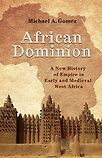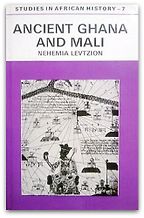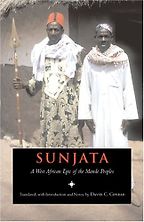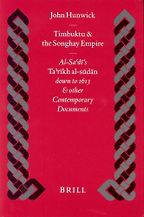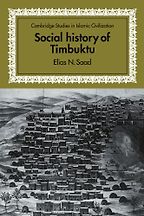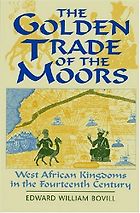The Ghana, Mali and Songhai Empires were the largest sub-Saharan African empires before the era of European colonialism. They covered a period from the 4th century until the 16th century, with the Mali Empire in particular having a very long history. Could you tell us when these empires were at their peak?
With respect to Ghana, we’re looking at the 9th through the 11th centuries as the apex of that formation—or series of formations. It was principally a Soninke State and it represents the moment in which the trade between the Mediterranean and West Africa resulted in a series of cultural changes all along the trade route, but in particular in what we’re calling ‘Ghana’.
With respect to Mali, I would say that the 14th century represents the apex of that empire, particularly Mansa Mousa’s period in power, although one could argue that the 13th century was also very critical. That saw the founding of the Mali Empire under Sunjata around the 1230s.
For the apex of Songhai power we’d have to go with Askia al-hajj Muhammad, who was in power from the latter part of the 15th century into the 16th century.
Those are the heights of each of those states. They represent a moment in the history of West Africa in which you have the opportunity for, and efflorescence of, cultural activity, but also the expression of political ideas, which are certainly influenced by external ideas, but ultimately represent West African values and a kind of West African cultural and conceptual framework for governance between those who rule and those who are ruled. All of this comes to the fore in the study of these three polities.
That is not to say that you can’t find similar things elsewhere. If we move further east to the lake Chad area, there was the Kanem-Bornu Empire, and even before we get there, for example, the Hausa City States. One can identify a kind of political genus with respect to how all these states form and how they conduct their activities. But, certainly, a lot of attention has been paid to the Ghana, Mali and Songhai Empires in books and the centuries that I’ve indicated represent when those states were at the height of their powers.
What are the particularly important or interesting reasons for studying these African empires and reading books on them?
One of the considerations, of course, is that, generally speaking, the world tends to be poorly informed about Africa and, in particular, about sub-Saharan Africa. The old Hegelian notion that nothing is there until we get to the colonial period in the 18th and 19th centuries tends to continue to be the way in which many people view the continent. So, it comes as a shock to many that, in fact, you had these imperial formations in the form of the Ghana, Mali and Songhai Empires, in West Africa, long before European incursions. I think that that helps to reset how we understand Africa, how we understand African people and the possibilities and potentialities of Africa.
“They represent a moment in the history of West Africa in which you have the opportunity for, and efflorescence of, cultural activity”
There is another thing as well. Oftentimes there is discussion about Neolithic valley civilizations with respect to Egypt and Nubia—what subsequently becomes Ethiopia. I view those as African societies, although, obviously, with Egypt and, to some extent Sudan, we’re talking about African societies that also became integrated into Arab societies. That’s a matter of historical development but, depending upon the context, the scholarship in these areas tends to be contested in terms of exactly to what part of the world these societies and cultures belong.
But we are more familiar with the Egypts, Nubias and Ethiopias of Africa as opposed to West Africa proper. And, for a long time, both in the secondary literature and certainly in the popular imagination, people had been working with ideas and notions about the Ghana, Mali and Songhai Empires that were in need of serious revision, and so that’s what I tried to address in my book, African Dominion.
Let’s get on to the books you’re recommending. First up is E.W. Bovill’s Golden Trade of the Moors. Tell us what this book’s about and what stories it tells us about this succession of empires in medieval and early modern West Africa.
Bovill’s book is about the trans-Saharan trade, between the Mediterranean and West Africa. It focuses specifically on the dynamics and dimensions of the trade in gold, also in human beings, and it sketches out the relationships between North Africa and West Africa. It’s wonderfully written in a lucid fashion. It can really be read both at the popular level as well as the scholarly level.
The work that it does—I don’t know if this was consciously or unconsciously—is to argue, effectively, for an understanding of North Africa and West Africa as conjoined regions. That is to say that you really can’t understand what’s happening in North Africa without understanding what’s happening in West Africa and conversely. That’s the implication—the book came out in the late 1950s, so that’s all they are, implications and inferences.
I would say that it isn’t until much later, around the turn of the 20th century into the 21st century, that we get to a point where we really begin to write in a way that articulates North and West Africa.
When you say “articulates North and West Africa”, what do you mean? How is that distinct from the thesis Bovill builds?
It’s not in distinction. What I’m saying is that Bovill lays the foundation, a groundwork, for that articulation. Implicit in his work is that these two regions are connected in ways that suggests a level of intimacy that belies a more colonial division—if you will—between the two regions.
We have this convention of North Africa and sub-Saharan Africa. And, in some contexts, that makes sense. In other contexts it really does violence to the realities of these regions, in that they were connected in vital ways. Another way of saying this is that the economies of North Africa were directly connected to West Africa and conversely. Similarly, the populations were connected. There was tremendous movement from north to south, from south to north and, obviously, plenty of cultural exchanges as well.
And does the book cover all three periods of these African empires, from the early Ghanaian Empire, right up to the Songhai Empire at its peak in the 16th century?
It does a better job with Ghana and Mali.
Let’s move on to your next book, Ancient Ghana and Mali by Nehemiah Levtzion.
This was the first publication in English that sought to recreate, or get at the histories of Ghana and Mali by bringing together the external sources written in Arabic about these places in periods and connecting them with the oral traditions, in particular with respect to Ghana.
We have to credit Levtzion with being one of the first people to construct a narrative and to try to connect these threads that, prior to the publication of this book in 1973, were a little disconnected. For example, with respect to Ghana—what we’re calling Ghana—you had the traditions, the oral traditions of the region, that refer to the kingdom of Wagadou. At the same time, you had West African chronicles that refer to the kingdom of Kayamagha and then you had the Arabic literature referring to Ghana—the land of gold. Levtzion was one of the first people to really bring those references together and to argue that they’re all talking about Ghana.
So he was one of the first to regularise our use of ‘Ghana’ and understand the ways in which the different types of sources connect with each other.
What language or languages are the West African chronicles that you mentioned written in?
They are also written in Arabic. Those sources are the Tarikh al-Fattash and Tarikh al-Sudan, ‘The History of the Seeker’ and ‘The History of the Blacks’. They were written in West Africa in Arabic. We’re having a debate over the circumstances and authorship and the productive phases of Tarikh al-Fattash. Scholars are not necessarily in agreement about that and I’m probably the outlier. We can have that conversation when we get on to African Dominion. But those are the 17th century chronicles that relate to Ghana as well as Mali.
Get the weekly Five Books newsletter
Levtzion brings these things together in a very effective fashion. It’s not so much of a polished narrative, in that it’s very clear as you read the book that he’s working through the materials. It’s an exercise in forensics, in trying to match the different sources and trying to give meaning to the sources. But he certainly laid the foundation and it’s a very important book.
Did he come up with a particular thesis or view as to what lay behind the creation of the Ghana and Mali Empires in his book? Was it based on a particular economic power? Presumably the people who built it were unifying disparate ethnic and cultural groups in West Africa. Does he have an idea about what the driving force behind the creation of these much larger states was?
He certainly builds on Bovill’s thesis that both regions, West Africa and North Africa, benefited from the trans-Saharan trade, particularly in gold, captives and other kinds of commodity. It’s clear that this trans-Saharan commerce was critical to both regions. But also, with Levtzion, we have a more scholarly treatment of the influence and infusion of Islam in the region. We have a better sense, as well, of notions of governance in the region.
And there is, arguably—there may be those who disagree with me—in Levtzion the influence of the earlier orientalists who worked on West Africa, in particular people like Delafosse, who saw Ghana-Mali-Songhai as a kind of continuum.
We’re talking about different parts of West Africa, with the centers of these states progressively moving from west to east and they represent the coming to power of different ethnic groups—the Soninke in Ghana, the Mandinka in Mali and then the Songhai, which is a reference to both the state, as well the language and a demographic.
But these earlier orientalists saw a thread and they argued for something that they called ‘Sudanic governance’. They saw these states as emblematic of a continuity of a particular theory of governance. You see some of that in Levtzion.
And were the Ghana, Mali and Songhai Empires, at their peaks, Islamic states?
No. What I argue in African Dominion is that, in fact, there was not one Ghana, but at least a couple of Ghanas and that, prior to the third quarter of the 11th century, the governance of Ghana was in the hands of non-Muslim people who practised an ancestral religion. But, as we move into the 12th century and beyond, we have a state—or a couple of states—that may have enjoyed some prominence but that began to decline. They are now Muslim polities, in that they are ruled by Muslim rulers.
When it comes to Mali and the founding of the Mali Empire in around 1230 by Sunjata, there’s a debate to be had. It’s clear that Islam is operative in the society, but it is less clear that Sunjata was himself Muslim. There is evidence that he was and that he wasn’t. There’s a notion that he may have attempted to practise a kind of mixture of ancestral religion and Islam.
“We have this convention of North Africa and sub-Saharan Africa. And, in some contexts that makes sense. In other contexts it really does violence to the realities of these regions”
It’s really not until we get to Mansa Musa that it’s very clear that the state is in the hands of a Muslim ruler. He effected a series of reforms while he was in power that resulted in Mali acquiring and enjoying a reputation as a Muslim state, both in West Africa and outside of West Africa.
Songhai as well was governed by Muslims. However, once again, that notion has to be attenuated because there’s controversy with respect to one of the rulers, Sunni Ali, as to whether or not he was Muslim. But theoretically the expectation was that Muslims should be in power in Songhai.
Let’s move on to Elias Saad’s Social History of Timbuktu. Why have you chosen this book?
It’s a very important book. He really got into the specifics and the minutiae of the scholarly community in Timbuktu. He was able to talk about these scholars in terms of their familial connections, how certain families’ roles and prominence in Timbuktu was translated into their projection as scholars and as holy men.
Timbuktu enjoys this reputation as having been a center of learning, particularly a center of Islamic learning in this early period. Saad goes behind that veneer and he looks at the constituent elements that contributed to Timbuktu’s formation. He talks about specific families, particularly the Muhammad Aqit family, and how you see these lines of transmission of authority, erudition and status through these families. He unfolds before us a more intimate story of the lives of the scholars and clerics in Timbuktu.
Did they establish particular schools there? Were they jurists or theologians or philosophers or scientists—what was the focus of their activities?
By way of context, the beauty of Timbuktu and, secondarily, of Jenne to the south, was that they represented opportunities for people to pursue erudition in one locale. Prior to the rise of Jenne and Timbuktu as sites of learning, the more familiar pattern was for someone who was seeking knowledge to travel from site to site to study with a particular teacher. You would go and study at the feet of a Sheikh and these teachers would be expert in particular branches of learning.
You might study poetry or the Hadith, the Sunna, the traditions of the Prophet, or Koranic exegesis—some branch of knowledge. You would go to a specific expert who was located in a particular town, or particular village to study with that person for X number of years. When that particular Sheikh was satisfied that you had acquired the necessary threshold of knowledge he would write a ‘jizya’—a license—verifying that you had studied these particular books and these particular principles with him, certifying that you have done that and that you yourself are now in a position to teach.
“Timbuktu enjoys this reputation as having been a center of learning, particularly a center of Islamic learning in this early period”
The problem is that you would have to travel over distances to study this or that form of knowledge. Timbuktu and Jenne represented universities in a loose sense, in that they housed multiple scholars who were expert in various branches of erudition. So you could go to Jenne, or more importantly to Timbuktu, and you could study the various branches of learning.
As well as the Islamic sciences, which I’ve already mentioned, you would study grammar, poetry and mathematics. Medicine and astronomy were also studied. Astronomy was important because these were lunar societies, so everything was predicated on the position and phases of the moon. One had to have a knowledge of stellar activity to organise society, knowing when holidays took place and so forth.
Through Saad’s work we understand the branches of knowledge and the specific books that were studied, as well as who taught them. We also get a sense of pedagogy, how things were taught. We get a sense of Islamic education at the madrasas, the ways in which young boys in particular, but also young girls up to a point, were educated. It’s a very important book.
Over what time period did Timbuktu flourish as a center of intellectual life? Was it over the same period as these empires’ flourishing? And did Timbuktu flourish as a result of being a university town—if I can put it like that—or was it already a big trading or administrative center, which subsequently attracted scholars?
It was definitely an important entrepot. It is the ‘port’ that interfaces most directly with trans-Saharan trade. Jenne is a major market as well. But the tendency was for commodities to exit Jenne and go to Timbuktu and then, from Timbuktu elsewhere through the Sahara.
So you have that kind of economic foundation. That economic foundation provides opportunities for individuals to pursue erudition as a way of life. Then, as the city develops a reputation as a site of erudition, of course you have pupils coming into the city for the purpose of studying and then that also becomes a source of revenue.
In African Dominion I argue that it’s actually Mansa Musa who really creates the basis for the efflorescence of Timbuktu as an educational center. That’s an early 14th century development. When he comes back from Hajj he’s able to invest in Timbuktu in a way that really allows the city to flourish. There was certainly scholarly activity in the city prior to Musa, but he advances the interest of the city as a cultural site. So, certainly from the middle of the 14th century through to the end of the 16th century, Timbuktu is flourishing as a very important site of learning, not just for West Africa, but for the larger Muslim world. You have not only West Africans, but people from North Africa, and from the central Islamic lands coming to Timbuktu, both to study and to teach.
And you mentioned at the beginning that particular patterns of political and moral thought that emerged within the Ghana, Mali and Songhai Empires drew on external influences, but also contained more idiosyncratic elements. Was Timbuktu a center for developing that?
I have a long chapter on the relationship of Timbuktu to notions of governance and, in particular, the relationship of Timbuktu to the imperial center of the Songhai, which was Gao, to the east of Timbuktu.
A lot of scholarship has argued that Timbuktu was autonomous and that the town’s elites, in particular the principal judges, the qadis of the town, were in control.
I beg to differ. I have argued that Timbuktu was, in fact, firmly within the control of the political apparatus of the state. It may be that Timbuktu influenced certain aspects of governance in Songhai because we do have the establishment of the office of the qadi, which by implication means that there was an attempt to adjudicate matters according to Sharia or Islamic law, at least within the cities and towns—I doubt very seriously if that effort was extended into more rural areas.
So, there was an attempt to make governance more ‘Islamic’ during the period of the Songhai, but that effort would have actually begun under Mansa Musa in Mali.
But your theory is that Mansa Musa very much sponsored the intellectual activity of Timbuktu in the service of his state building?
Without question. Because when Mansa Musa returns from the pilgrimage he embarks upon a policy whereby he sends Mande-speaking individuals to Fez to study and, upon completion of their studies, they are incorporated into Jenne and Timbuktu and become the intellectual leaders of the cities over a period of time. And they are the basis for a subsequent flourishing of scholarship in those cities. Mansa Musa was definitely trying to build up this religious and scholarly dimension and that resulted in the formation of a clerical caste that was loyal to Mali.
The competition is with the Tuareg. And so there is a constant back and forth over who’s going to control Timbuktu, the Tuareg to the north or states to the south or east. Mansa Musa very deliberately wanted to create a scholarly clerical formation in Timbuktu that would be loyal to the state.
Your fourth book on the African empires is David Conrad’s Sunjata: A West African Epic of the Mande Peoples. What story does this tell us?
Conrad is a superb scholar, an expert in the oral traditions of the Mande. He is wrestling with all of the various traditions that concern Sunjata. It’s an interesting problem because it gets at the question of the relevance of oral traditions for anterior historical developments in West Africa.
The principal problem, of course, is that the traditions, by and large, were collected in the 18th century and beyond. But they purport to talk about developments in the early 13th century. So the question is: how reliable are they? Are they really about circumstances in the 13th century or do they speak more to the context within which they were developed, in the 18th and 19th centuries?
Conrad wrestles with this question and he is very attuned to the sociological interpretations of the traditions, the ways in which the traditions work, how they were collected and the themes of the different traditions. So we owe a tremendous debt of gratitude to Conrad for these collections and for his critical analysis of them.
Are we talking about a single poem here? It sounds, from what you’re saying, that it’s more than that.
The most popularised version has been published in French and English, maybe other languages, by Djibril Niane as Sunjata: The Epic of Old Mali. That is the popular version. But Niane did some work of his own in collecting oral traditions, in particular from one griot [a West African bard-cum-royal advisor]. He also conducted his own scholarly research into Mali, as well as other dimensions of West African history. So, he has a context out of which he was approaching this material. Niane refers to it as an epic and I like that. I have adopted that same kind of characterization in African Dominion.
“The challenge is to try to figure out what’s myth and what’s not”
There are those who don’t believe that it’s an epic and, of course, it cannot be separated from other kinds of traditions in other parts of Africa and outside of Africa. The objective is to try to determine what parts of these traditions are indigenous to the region and the degree to which they may shed light on historical development. These are the challenges—but there are lots and lots of these traditions. There is this epic that Niane weaves together, but there are other collections that purport to represent the life of Sunjata, or some aspect of his life and those collections continued on into the 20th century.
Do these lives of Sunjata constantly focus on particular themes that the tell us something about the cultural preoccupations of the people who produced them?
Yes. In my view there are threads that are common to the story of Sunjata. One relates to his origins and his mother. I argue that represents an effort to talk about the disempowerment of women in society. I think that’s one theme. In the Islamization of Mali there seems to be a process of the disempowerment of women, who formerly held political positions—overtly political positions. I think that’s one of the things that you see. I think another theme in various traditions is the supernatural quality of Sunjata’s early life which, of course, is an effort to identify him as someone who was divinely chosen to establish the Empire.
Another theme has to do with sibling rivalry as he’s growing up and maturing, his rejection by one part of the royal family and his going into exile which, of course, is a very common theme in many other sagas. The subsequent theme is how he is able to establish relationships with other polities, other entities, that will eventually become the building blocks for the Empire, once he becomes its leader. And then there are the sequences around war with the Susu, which is another Mande-speaking group, under the rule of Sumanguru and his defeat of Sumanguru and the establishment of the Empire. These are the constitutive elements that you will see referred to in all of these different traditions.
Five Books interviews are expensive to produce. If you're enjoying this interview, please support us by donating a small amount.
The challenge is to try to figure out what’s myth and what’s not. Scholars are going back and forth about that. What I try to do is make an argument for the reconsideration of oral traditions as a legitimate source of information for this distant past. I make a tri-level argument and always insist that no historical development can be established if it’s not corroborated by an independent source. With that understood, I think that there are some basic elements about the life of Sunjata that can be substantiated: that Sunjata did exist, and that there was war with the Susu. These are matters that have been independently established by people like Ibn Khaldun.
Beyond that we get into the specifics and what I try to do in African Dominion is to talk about what was likely and what was unlikely.
Last up of the books you’ve chosen is John Hunwick’s Timbuktu and the Songhay Empire.
I had to put John’s work in there. John was the preeminent scholar on Songhai. He was one of my mentors. I took my PhD at the University of Chicago. John was at Northwestern while I was at Chicago and so I studied with him and I’m entirely indebted to him for my interest in Songhai. He has produced a lot of material. This is just one of the things that he wrote. And it’s actually a translation of part of Tarihk al-Sudan. It’s an excellent translation of this source. But the translation is preceded by a very important, long essay that seeks to knit together the constitutive elements of Songhai history. That’s why I chose this book.
And what is the Tarikh al-Sudan?
Literally, ‘a History of the Blacks’. It is one of the chronicles written in West Africa, completed in the 17th century. The Tarikh al-Sudan actually focuses on developments in Timbuktu. There is a very brief mention of the interior history and then it gets right into the goings-on in Timbuktu.
There is political history embedded in Tarikh al-Sudan. But then it also moves beyond the moment of the Moroccan conquest of Songhai in 1591, and it moves into the post-1591 period. It moves into a discussion of the early Moroccan occupation of Timbuktu and this period of the Arma, which is a reference to the fact that the Moroccans will come into Timbuktu and conquer largely because they have rifles. There is also a discussion of what we refer to as the puppet Askias. The Askias were a dynasty established by Muhammad Ture who overthrew Sunni Ali and his son, who were the legitimate rulers.
He established this dynasty, the Askia Dynasty, in conjunction with very powerful collaborators in Timbuktu. And so when Songhai is defeated in 1591, there’s an attempt to continue to control parts of Songhai through a series of Askias, who are referred to as puppet Askias because they are controlled by Moroccan forces in Timbuktu.
“Songhai shrivels until, basically, it is just represented by the territory immediately around Timbuktu. So, 1591 is really the death knell for Songhai”
What we see happen post-1591 is the gradual diminution of Moroccan authority over what’s happening at Timbuktu. The Moroccans in Morocco gradually lose interest in what’s happening in Timbuktu. It’s not what they thought it was going to be. They thought they were going to go in there and find large caches of gold to finance their wars in Iberia. In fact that was not the case. They did not really understand the dynamics of the gold trade, so they lost interest.
What you have is an indigenisation of those Moroccans who remain in Timbuktu and their descendants. They intermarried with families in what was Songhai and they become more and more independent of Morocco. But there’s an atrophying of power and Songhai shrivels until, basically, it is just represented by the territory immediately around Timbuktu. So, 1591 is really the death knell for Songhai.
I’m not saying what happens thereafter is of no interest or consequence, but it’s a very different political formation.
Before we go, can you just tell us a bit about your own book on the Ghana, Mali and Songhai Empires, African Dominion? Can you give us a sense of what story you were trying to tell or gaps you were trying to fill?
Since Levtzion’s 1973 work there had been no extended discussion of this period. That’s quite a long time. So, there was a need to revisit this place and period.
In my exploration of the materials I argue that what we have is an unfolding of institutions and conventions. We need to understand that governance is in formation, that social conventions are in formation and that notions of power and gender relations are in formation. The institution of slavery is unfolding. What we see in looking at developments from Ghana through Songhai is a series of social, political and cultural movements that represent a very dynamic period in the history of West Africa. I’m trying to understand how that takes place.
In the secondary literature on West Africa is the notion that, when we get to the 18th and 19th centuries, West Africa, at least in the savanna and Sahel, undergoes a series of religious and political reforms as a result of a series of holy wars, or jihads. These result in the establishment of theocracies toward the end of the 17th century in what is now eastern Senegal and the highlands of what is now Guinea and, from the 1770s, in the Middle Senegal Valley. There is the establishment of the so-called Sokoto Caliphate in what is now Northern Nigeria from 1804 to 1812 and the conquests of el-Hadj Omar in the mid-19th century, which span the area from the Middle Senegal Valley all the way to Timbuktu. There are developments in Macina and the establishment of the Hamdullahi Caliphate in the 1810s. There is a lot of activity.
What I see, however, looking at Ghana earlier on, is a period of similar activity along the Senegal Valley—the Middle Senegal Valley and Upper Senegal Valley—very early, in the 11th century. And so I revisit the whole question of the Almoravids. The Almoravids take off and will constitute the dynasty that establishes Berber control of portions of North Africa and portions of Iberia. But what’s interesting to me is that the Amoravids have their start in the Middle Senegal Valley. I revisit that question and the consequences for the Middle and Upper Senegal Valley of the Almoravid movement. What I argue is that there is, indeed, this tradition of reform and that this, arguably, has antecedents in the 11th and 12th centuries with the re-formation of Ghana as a kind of reformed state, although I’m not saying that it was a theocracy by any means.
I move on to a discussion of Sunjata, where I’m trying to revisit the role of the oral traditions, but the point there is that, in the 14th century under Mansa Musa, we have this expansive state. It’s an empire that stretched from the Atlantic Ocean all the way to the Niger Valley. This is an extraordinary moment in West African history and it represents a moment in which West Africa aspires to be a world power. I’m suggesting that the hajj of Mansa Musa is an exploration of how Mali moves from being a regional power to a trans-regional power and into a world player. I argue that Mali was constrained because its center was in the savanna and so it was constrained by a huge desert to the north, and by the Atlantic Ocean to the south. It tried to overcome those constraints, but was unable to do so, mainly because it had not achieved a level of technological innovation that would have allowed it to navigate the Atlantic successfully, nor is it in control of the trans-Saharan trade. So it’s kind of landlocked and unable to experience its full potential.
“This is a polyethnic state, and a multicultural state. This is the first time that we see this in West Africa and there were some very interesting political experiments going on”
Songhai inherits the mantle from Mali. Although Mail continued on in some form, it gradually diminishes as Songhai rises. With Songhai we see another imperial formation and we see a real interest in experimentation with how the state comes together. I would argue that you see for the first time the notion of a quasi-citizenship under Askia Muhammad, where we see the emergence of a new political identity in which prior loyalties to ethnicity or to religious communities are superseded by an allegiance to the state. This is a polyethnic state, and a multicultural state. This is the first time that we see this in West Africa and there were some very interesting political experiments going on.
The relationship between ‘mosque and state’ as opposed to ‘church and state’ is something that is explored and worked out, that is a relationship between Gao, the imperial center, and Timbuktu primarily, and Jenne secondarily, as centers of spiritual power. All of that is worked through.
There is a notion of expansion under Mansa Musa in particular. There’s this notion that Mali is aspiring to, perhaps, reach the Mediterranean, to effect a partnership with Egypt in North Africa. We don’t see a similar kind of attitude displayed with Songhai. What happens with Songhai is that it is overtaken by the turmoil within the ruling dynasty. It’s very unfortunate because this turmoil effectively results in fratricidal infighting that weakened the state at the very moment that the Moroccans were becoming more interested in Songhai and at the very moment that Europeans are beginning to circumnavigate the West African littoral.
I argue that there is a situation in which, at the very moment that West Africa needs a champion and at the moment when Songhai best qualifies as that champion in relation to external threats, Songhai was imploding. And the consequence was the Moroccan conquest of 1591.
Interview by Benedict King
November 6, 2020. Updated: February 14, 2023
Five Books aims to keep its book recommendations and interviews up to date. If you are the interviewee and would like to update your choice of books (or even just what you say about them) please email us at [email protected]

